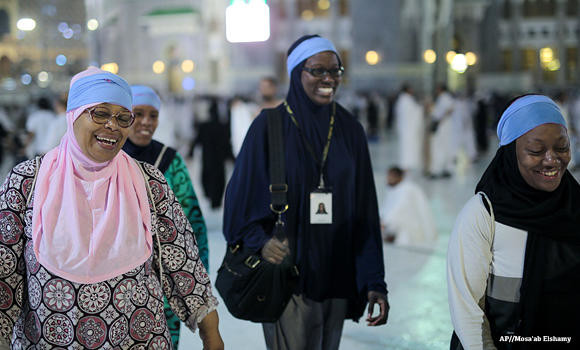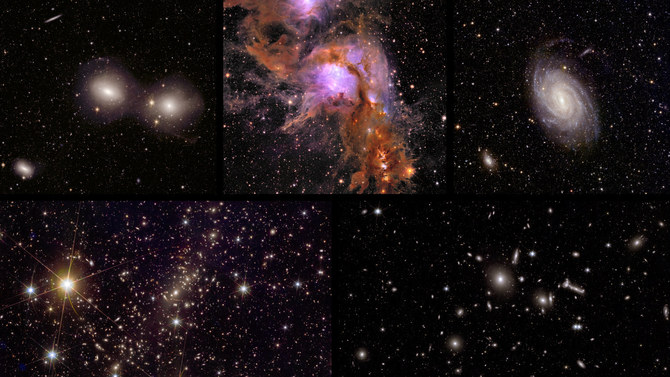MECCA, Saudi Arabia: As Shahidah Sharif, an African-American Muslim, joined millions of fellow pilgrims from around the world on the Haj this year, she felt a renewed connection. To her own “blackness,” she says, but also to humanity as a whole.
“When the human family becomes more important than just myself and my needs, nothing can get in the way of building relationships,” she told The Associated Press in Makkah. “It doesn’t matter if we have different faiths, different races, different nationalities, I can find something in common with you.”
For American black Muslims, this year brought a significant landmark, the 50th anniversary of Malcolm X’s death. A year before his assassination, Malcolm X underwent a transformative experience on the Haj, seeing the potential for racial co-existence after witnessing, as he wrote, pilgrims “of all colors displaying a spirit of unity and brotherhood that my experiences in America had led me to believe could never exist between a white and a non-white.”
This year’s Haj, which ended Saturday, came at a time when the debate over race in the United States is at its most heated in decades, with the Black Lives Matters movement arising after the deaths of a number of black men at the hands of police were captured on camera and seen widely by the public.
The AP spoke with a number of African-Americans about their Haj experience. For Muslims, the pilgrimage is not just a duty, it’s a moment to reflect on oneself and on community. It’s an intensely personal experience. In Islam, each pilgrim presents him or herself directly to God, seeking forgiveness of sin, while performing rituals that include circling the Kaaba. At the same time, it’s communal: more than 2 million pilgrims performing the same rites, underscoring unity and equality.
The scale is exhausting. The population of a city packs into tents, walks simultaneously from site to site in the desert in broiling heat for five days. A stampede this year that killed at least 769 pilgrims underscored the dangers of the crowds.
For the African-Americans who spoke to the AP, all those factors weighed on how Haj affected their faith and their sense of community back home in America.
___
Sharif draws inspiration from Hagar, the wife of the prophet Ibrahim — Abraham, as he’s known in the Bible. In Islamic tradition, Hagar and her son Ismail — the Bible’s Ishmael — were left in the desert at what is now Makkah, and Hagar ran through the hills searching for water for her thirsty child until God opened the spring of Zamzam. Pilgrims re-create her search in a Haj rite.
For Sharif, the mother of two young children, it’s a lesson in sacrifice. “Who am I in this scheme of history that I can’t make a sacrifice for the greater good, in particular for our community?” she said. The Haj helps make her a better American, she said, by instilling her with compassion.
The 38-year-old Sharif and her husband, Suleimaan Hamed, run Haj Pros, a company based in Atlanta, Georgia, organizing Haj trips. This year they came with more than 30 African-Americans. Her parents were members of the Nation of Islam, but like Malcolm X, they moved to more mainstream Sunni Islam. Still, she says current activists can learn from the Nation of Islam of the 1960s.
“We need to remove the idea of seeking permission from someone to give us what’s inherently ours,” she said. “No one needs to validate who we are. We know who we are, and we’re inherently created by God.”
___
“Pack your patience, and wear it,” Sharif’s husband Hamed always tells the American pilgrims he guides. Patience is key to dealing with the crowds. Another piece of advice: “Take off your American glasses.”
“We see everything through the lens of America, and those glasses are dirty. Everything’s racism, everything’s oppression,” he said. While he says this is the reality in the US, he says there are other cultural factors that could be at play in Saudi Arabia during the Haj.
For him, Haj provides a model in Abraham, who in Islamic tradition built the Kaaba. “All the lessons for life are in him ... how to build a community,” said Hamed, who is also the imam, or preacher, at the Atlanta Masjid mosque.
His final advice to pilgrims: Trust that God “has an experience for you as an individual in the midst of 3 million people ... He has something for you individually.”
___
Praying in the Grand Mosque housing the Kaaba with people from all over the world, Jamila Rashid felt “how beautiful the human family is and that you’re all essentially human beings.”
But, she added, that can be “a little dangerous.”
“It can lull you into thinking that color doesn’t matter, that race doesn’t matter and that our goal should be to be color-blind,” she said. Everyone “has their own story ... their own struggle,” she said, “so if we as black people aren’t going to stand up and talk about the fact that our lives matter just like everybody else’s, who’s going to do that?“
She’s glad Americans are talking about race, though with so much of it on social media, she’s concerned how much depth it has.
She said a lesson must be taken from the earlier generation, when the civil rights movement had clear demands. “Okay, black lives matter, so what are we asking for?” she said.
Rashid describes herself as “a minority trifecta“: a woman, an African-American and a Muslim. She brings those perspectives into her work in Atlanta, as founding director of My World, a non-profit that teaches teens leadership skills and cross-culture citizenship.
Having just turned 40, she says the pilgrimage builds her “spiritual muscles” for whatever comes next, so “I’m really able to perform my purpose, understanding that God does not give you more than you can bear.”
___
At 66, Habeebah Muhammad Abdul-Wali has lived through many phases of the civil rights struggle.
When Martin Luther King, Jr. was assassinated in 1968, she marched in protests. She was in the Black Power movement. And in 1972, she converted and joined the Nation of Islam, though now she’s a mainstream Sunni.
She says “history is repeating itself” with the current protests in the US But, for her, there’s a difference: Back then, she saw greater seriousness, greater sincerity.
Seeing stories of young black men killed by police makes her stressed. “I just turn to Allah to give that calmness.”
Now on her first Haj, the retired school-teacher sought to “purge” herself of negativity and become a more patient, kinder person — “because I’m getting over the hill, now it’s my time. ... I want to try to be good, stop making frowns.”
She talked about the hardships of the pilgrimage, of sleeping one night outside on the ground, of sharing bathrooms with strangers. “Allah is showing me that everybody is not the same, so you have to learn to tolerate people.”
As she circled the Kaaba, she thought, “This is what Malcolm X must have experienced, seeing people from different walks of life ... and I just said ‘Wow, Allah chose us to be here in this circle of Islam.”
____
Zainab Nasir wiped away tears as she spoke of her pilgrimage. “You’re going to have to excuse me because I’m very emotional with this.”
She compared it to a baby emerging from the womb. “I’m coming closer and closer to being reborn,” the 59-year-old from Oakland, California, said. “Inshallah, all my sins will be removed.”
Nasir has six sons and a daughter. She worries about her younger sons, aged 21 and 25. If they get stopped by police, she said, “they need to know how to react in a way that won’t get them sent to jail or possibly killed.”
One of her older sons, Yusuf, is with her on the Haj. “I’m praying that, you know, we will be the good example for my younger children.”
“Allah has given me a second chance ... So what am I going to do with this when I get home?” she said. She says she knows that, being human, she can always fall back into sin and will need God’s forgiveness.
“You fool yourself if you think ‘OK I’m changed,’ because you’re not. It’s a transition.”
The Haj journey of black Americans 50 years after Malcolm X
The Haj journey of black Americans 50 years after Malcolm X

Kodi, star of ‘Dog on Trial,’ takes home Cannes’ top dog prize

- The Griffon mix was praised for his “breathtaking” performance as Cosmos, a guide dog for a visually impaired man
- Xin, the greyhound who made a star turn in Chinese director Guan Hu’s “Black Dog,” was awarded the Palm Dog’s Grand Jury Prize
CANNES, France: There was lots of tail-wagging and face-licking as Kodi, this year’s winner of the Palm Dog, the canine equivalent of the Cannes Film Festival’s top prize, went up to receive his red collar for the French comedy “Dog on Trial” on Friday.
The Griffon mix was praised for his “breathtaking” performance as Cosmos, a guide dog for a visually impaired man, who goes on trial over an attack, in a case whose outcome could mean death.
“This film is very significant because it not only explores the bond between humans and dogs but it takes a satirical, comedic but quite profound look at the way that we domesticate dogs and the way that we relate to dogs, and the way our justice system relates to dogs,” said critic and jury member Anna Smith.
Xin, the greyhound who made a star turn in Chinese director Guan Hu’s “Black Dog,” was awarded the Palm Dog’s Grand Jury Prize.
Xin was in Cannes to don the red collar for the film about an ex-convict tasked with ridding his town of stray dogs who befriends one of them.
The unofficial awards show, which was created in 2001, is now in its 24th edition.
Kodi succeeds last year’s winner, Messi from Justine Triet’s “Anatomy of a Fall,” who converted his star power into a French TV show in which he, through the voice of French humorist Raphael Mezrahi, interviews people at this year’s festival.
Other past winners include Brandy, a pit bull belonging to Brad Pitt’s character in “Once Upon a Time in Hollywood” and Tilda Swinton’s spaniels, who co-starred with her in a film directed by Joanna Hogg.
Massive cradle of baby stars revealed in new space telescope images

- The European Space Agency released the photos from the Euclid observatory on Thursday
- Euclid will spend the next several years observing billions of galaxies covering more than one-third of the sky
CAPE CANAVERAL, Florida: A massive cradle of baby stars has been observed in new detail by a European space telescope, adding to its celestial collection of images.
The European Space Agency released the photos from the Euclid observatory on Thursday.
They were taken following the telescope’s Florida launch last year as a warm-up act to its main job currently underway: surveying the so-called dark universe.
From its perch 1 million miles (1.6 million kilometers) from Earth, Euclid will spend the next several years observing billions of galaxies covering more than one-third of the sky.
The shape and size of all these galaxies can help scientists understand the mysterious dark energy and dark matter that make up most of the universe.
“Euclid is at the very beginning of its exciting journey to map the structure of the universe,” the space agency’s director general, Josef Aschbacher, said in a statement.
Among the newly released pictures is one of an enormous cradle of baby stars some 1,300 light-years away known as Messier 78. A light-year is 5.8 trillion miles. Euclid’s infrared camera peered through the dust enveloping the stellar nursery, revealing new regions of star formation, according to ESA.
Daily marijuana use outpaces daily drinking in the US, a new study says

- In 2022, an estimated 17.7 million people reported using marijuana daily or near-daily compared to 14.7 million daily or near-daily drinkers,
- The number of daily users suggests that more people are at risk for developing problematic cannabis use or addiction, says researcher
For the first time, the number of Americans who use marijuana just about every day has surpassed the number who drink that often, a shift some 40 years in the making as recreational pot use became more mainstream and legal in nearly half of US states.
In 2022, an estimated 17.7 million people reported using marijuana daily or near-daily compared to 14.7 million daily or near-daily drinkers, according an analysis of national survey data. In 1992, when daily pot use hit a low point, less than 1 million people said they used marijuana nearly every day.
Alcohol is still more widely used, but 2022 was the first time this intensive level of marijuana use overtook daily and near-daily drinking, said the study’s author, Jonathan Caulkins, a cannabis policy researcher at Carnegie Mellon University.
“A good 40 percent of current cannabis users are using it daily or near daily, a pattern that is more associated with tobacco use than typical alcohol use,” Caulkins said.

The research, based on data from the National Survey on Drug Use and Health, was published Wednesday in the journal Addiction. The survey is a highly regarded source of self-reported estimates of tobacco, alcohol and drug use in the United States.
From 1992 to 2022, the per capita rate of reporting daily or near-daily marijuana use increased 15-fold. Caulkins acknowledged in the study that people may be more willing to report marijuana use as public acceptance grows, which could boost the increase.
Most states now allow medical or recreational marijuana, though it remains illegal at the federal level. In November, Florida voters will decide on a constitutional amendment allowing recreational cannabis, and the federal government is moving to reclassify marijuana as a less dangerous drug.
Research shows that high-frequency users are more likely to become addicted to marijuana, said Dr. David A. Gorelick, a psychiatry professor at the University of Maryland School of Medicine, who was not involved in the study.
The number of daily users suggests that more people are at risk for developing problematic cannabis use or addiction, Gorelick said.
“High frequency use also increases the risk of developing cannabis-associated psychosis,” a severe condition where a person loses touch with reality, he said.
Russian court fines man for hair dyed in colors of Ukrainian flag, OVD-Info says

- Photographs of Stanislav Netesov posted online show the 25-year-old’s close-cropped hair colored bright blue, green and yellow
- Netesov was found guilty of discrediting the armed forces on May 3, an online court notice shows, although it does not specify a fine
LONDON: A Russian man who had his hair dyed in some of the colors of the Ukrainian flag has been fined 30,000 roubles ($330) by a court for “discrediting” the Russian army, rights group OVD-Info reported on Monday.
Photographs of Stanislav Netesov posted online show the 25-year-old’s close-cropped hair colored bright blue, green and yellow. Blue and yellow are the colors of the Ukrainian flag.
More than 20,000 people have been detained for their anti-war stance since the start of Moscow’s full-scale invasion of Ukraine in February 2022, with over 900 people charged with criminal offenses.
Netesov was found guilty of discrediting the armed forces on May 3, an online court notice shows, although it does not specify a fine.
In court, Netesov denied his hair color was meant as a statement of protest, saying that he does not support either Ukraine or the Russian army, independent news outlet Mediazona reported. He said he has dyed his hair bright colors for years.
Netesov could not be reached for comment.
The case against the Muscovite began in late April, when he was attacked by unknown people while returning home from work late at night.
The assailants stole his mobile phone and knocked out one of his teeth, Netesov told OVD-Info, which assists those targeted for opposing the war.
When he went to the police to file a report, officers noticed his hair and charged him under the “discrediting” statute, Mediazona reported.
“The aforementioned visual propaganda clearly expressed a negative attitude toward the Armed Forces of the Russian Federation,” Mediazona cited the police report as saying.
Officers also gave Netesov a summons to report to a military enlistment office. He then revealed to them he was a transgender man, after which they canceled the summons, Mediazona said.
Swarmed with tourists, Japan town blocks off viral view of Mt. Fuji

- The mass of visitors and their refusal to obey rules on littering and parking had become a nuisance and traffic hazard
FUJIKAWAGUCHIKO, Japan: Japan’s majestic Mt. Fuji was some 700,000 years in the making, but on one sultry May morning, it was gone.
At least on one side of a busy road, views of the 3,776-meter (12,388 foot) symbol of Japan and the Lawson convenience store beneath it have vanished, as officials finished a 20-meter by 2.5-meter barrier to obstruct a photo spot that had become viral among tourists.
For locals, the mass of visitors and their refusal to obey rules on littering and parking had become a nuisance and traffic hazard.
“I’m really happy that foreigners are coming to our town,” said Kikue Katsumata, 73, a lifelong resident of Fujikawaguchiko. “But when it comes to taking pictures from the Lawson, the road is a bit narrow and it can be dangerous when people dash across without using a crosswalk.”
March and April set all-time records for visitor arrivals, driven by pent-up demand after the pandemic and as the yen’s slide to a 34-year low made Japan an irresistible bargain. That’s been good news for the economy, with travelers spending a record 1.75 trillion yen ($11.2 billion) in the first three months of 2024, according to the tourist agency.
The drastic decision to block the view of Mt. Fuji symbolizes tensions across the country as Japan reckons with the consequences of its tourism boom. The western metropolis of Osaka and the hot spring resort town Hakone are among municipalities considering new tourism taxes to deal with deluge of visitors.
Cyril Malchand, a 45-year old visitor from France, found out about the fence online and made a special trip to be among the last to take in the view. He said he empathized with the locals.
“When I see that there could be problems with people crossing the road without watching cars, I don’t find it that bad that they’re setting up that fence,” he said.

















